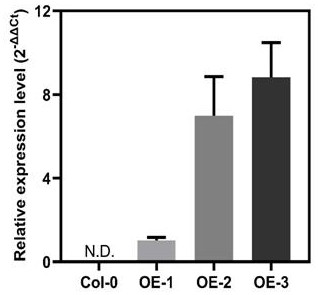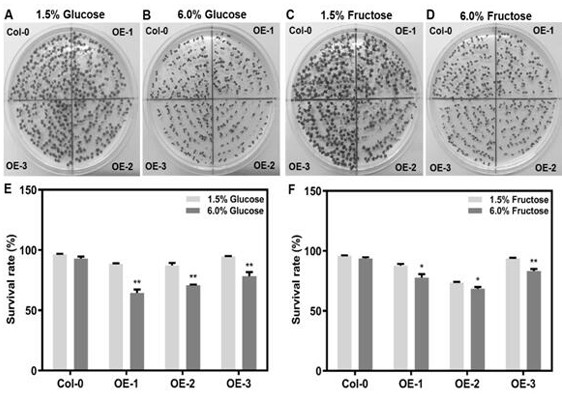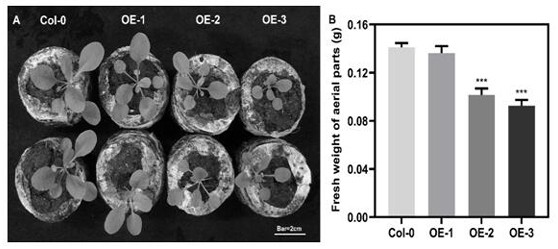Application of camellia sinensis hexokinase CsHXK3 gene in regulating and controlling plant growth and development and enhancing cold resistance
A hexokinase and plant growth technology, applied in the field of biogenetic engineering, can solve the problems of complicated breeding procedures, immaturity, and low breeding efficiency
- Summary
- Abstract
- Description
- Claims
- Application Information
AI Technical Summary
Benefits of technology
Problems solved by technology
Method used
Image
Examples
Embodiment 1
[0026] Embodiment 1: Cloning and overexpression vector construction of tea tree CsHXK3 gene
[0027] According to the CsHXK3 sequence published in the NCBI database, its nucleotide sequence is shown in SEQ ID NO. 1, and the amino acid sequence of its encoded protein is shown in SEQ ID NO. As a template, the CsHXK3 gene was amplified by PCR. Ligate the amplified sequence into pENTR TM / D-TOPO carrier, finally connected to the pH7FWG2 plant expression vector by LR reaction.
[0028] The upstream primer F used: 5'-CACCATGGGGAAGGTAGGGTTG-3' is shown in SEQ ID NO. 3; the downstream primer R: 5'-TAGCAACTGTACGGTATCCACATT-3' is shown in SEQ ID NO. 4.
Embodiment 2
[0029] Embodiment 2: Construction and screening of CsHXK3 gene overexpression plants
[0030] The vector successfully constructed in Example 1 was transformed into the Agrobacterium strain GV3101, and then transformed into wild-type Arabidopsis thaliana by the flower soaking method, and the seeds of the T0 generation of transgenic Arabidopsis thaliana were harvested. The selection resistance gene carried by the pH7FWG2 vector is hygromycin. Therefore, use hygromycin to positively select the transgenic seedlings of Arabidopsis thaliana, harvest the positive seedlings of the T1 generation with hygromycin resistance, and then test the T1 The seeds of the first generation were screened for hygromycin resistance, the segregation ratio was identified, and the line with resistant seedlings: non-resistant seedlings was about 3:1, indicating that in this line, the carrier sequence carrying the CsHXK3 gene was a single copy form into the plant genome. The T2 generation seedlings with h...
Embodiment 3
[0032] Example 3: Growth and development phenotypes of plants overexpressing CsHXK3
[0033] Seeds of wild-type, OE-1, OE-2 and OE-3 Arabidopsis were sown on 1 / 2 MS solid medium with 1.5% glucose and 6.0% glucose and 1.5% fructose and 6.0% fructose, and the seed germination growth state See figure 2 A, B, C and D. Wild-type seeds could germinate healthily on the medium containing 1.5% and 6.0% glucose, and there was no significant difference in survival rate ( figure 2 E), while the seed survival rate of the three overexpression lines on the medium containing 6.0% glucose was significantly lower than that of 1.5% glucose ( figure 2 e). Similarly, compared with the wild type, the seed survival rate of the three overexpression lines on the medium containing 6.0% fructose was significantly lower than that of 1.5% fructose ( figure 2 F). The results showed that CsHXK3 could sense the sugar concentration signal and participate in the regulation of plant seed growth and ger...
PUM
 Login to View More
Login to View More Abstract
Description
Claims
Application Information
 Login to View More
Login to View More - R&D
- Intellectual Property
- Life Sciences
- Materials
- Tech Scout
- Unparalleled Data Quality
- Higher Quality Content
- 60% Fewer Hallucinations
Browse by: Latest US Patents, China's latest patents, Technical Efficacy Thesaurus, Application Domain, Technology Topic, Popular Technical Reports.
© 2025 PatSnap. All rights reserved.Legal|Privacy policy|Modern Slavery Act Transparency Statement|Sitemap|About US| Contact US: help@patsnap.com



